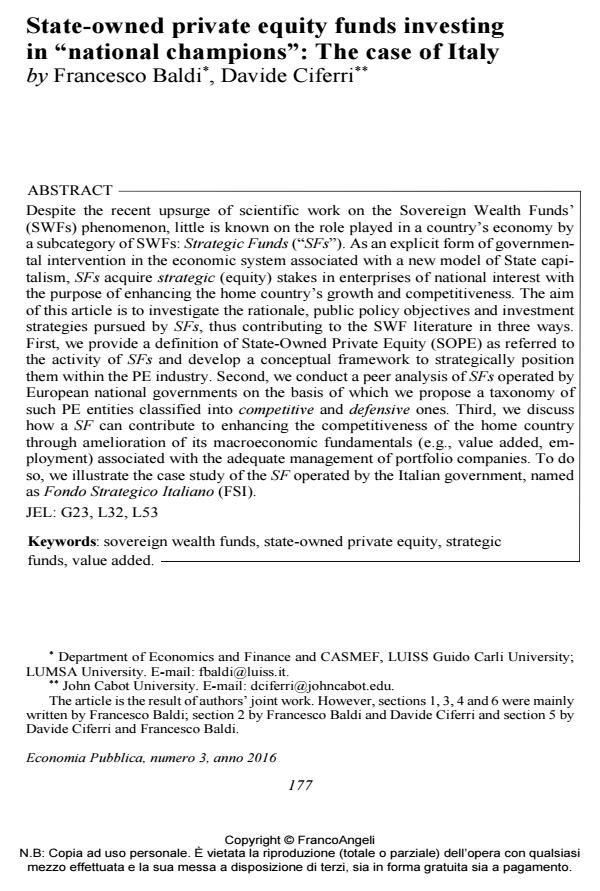State-owned private equity funds investing in "national champions": The case of Italy
Titolo Rivista ECONOMIA PUBBLICA
Autori/Curatori Francesco Baldi, Davide Ciferri
Anno di pubblicazione 2017 Fascicolo 2016/3
Lingua Inglese Numero pagine 42 P. 177-218 Dimensione file 507 KB
DOI 10.3280/EP2016-003007
Il DOI è il codice a barre della proprietà intellettuale: per saperne di più
clicca qui
Qui sotto puoi vedere in anteprima la prima pagina di questo articolo.
Se questo articolo ti interessa, lo puoi acquistare (e scaricare in formato pdf) seguendo le facili indicazioni per acquistare il download credit. Acquista Download Credits per scaricare questo Articolo in formato PDF

FrancoAngeli è membro della Publishers International Linking Association, Inc (PILA)associazione indipendente e non profit per facilitare (attraverso i servizi tecnologici implementati da CrossRef.org) l’accesso degli studiosi ai contenuti digitali nelle pubblicazioni professionali e scientifiche
Despite the recent upsurge of scientific work on the Sovereign Wealth Funds’ (SWFs) phenomenon, little is known on the role played in a country’s economy by a subcategory of SWFs: Strategic Funds ("SFs"). As an explicit form of governmental intervention in the economic system associated with a new model of State capitalism, SFs acquire strategic (equity) stakes in enterprises of national interest with the purpose of enhancing the home country’s growth and competitiveness. The aim of this article is to investigate the rationale, public policy objectives and investment strategies pursued by SFs, thus contributing to the SWF literature in three ways. First, we provide a definition of State-Owned Private Equity (SOPE) as referred to the activity of SFs and develop a conceptual framework to strategically position them within the PE industry. Second, we conduct a peer analysis of SFs operated by European national governments on the basis of which we propose a taxonomy of such PE entities classified into competitive and defensive ones. Third, we discuss how a SF can contribute to enhancing the competitiveness of the home country through amelioration of its macroeconomic fundamentals (e.g., value added, employment) associated with the adequate management of portfolio companies. To do so, we illustrate the case study of the SF operated by the Italian government, named as Fondo Strategico Italiano (FSI).
Parole chiave:Sovereign wealth funds, state-owned private equity, strategic funds, value added.
Jel codes:G23, L32, L53
- Rationales, performance and governance of public entreprises. Editorial introduction Luc Bernier, Massimo Florio, Johan Willner, in ECONOMIA PUBBLICA 3/2017 pp.5
DOI: 10.3280/EP2016-003001
Francesco Baldi, Davide Ciferri, State-owned private equity funds investing in "national champions": The case of Italy in "ECONOMIA PUBBLICA " 3/2016, pp 177-218, DOI: 10.3280/EP2016-003007